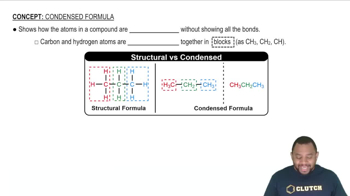Here are the essential concepts you must grasp in order to answer the question correctly.
Lewis Structures
Lewis structures are diagrams that represent the bonding between atoms in a molecule and the lone pairs of electrons that may exist. They use dots to represent electrons and lines to represent bonds between atoms. Understanding how to draw Lewis structures is essential for visualizing molecular geometry and predicting reactivity.
Recommended video:
Lewis Dot Structures: Ions
Condensed Structural Formula
A condensed structural formula provides a shorthand way of representing the structure of a molecule, showing how atoms are connected without depicting all the bonds explicitly. For example, in CH3CHO, the formula indicates that there are two carbon atoms, with one being part of a carbonyl group (C=O) and the other connected to three hydrogens, which helps in determining the arrangement of atoms in the Lewis structure.
Recommended video:
Valence Electrons
Valence electrons are the outermost electrons of an atom and are crucial for forming bonds with other atoms. The number of valence electrons determines how atoms will bond and the overall structure of the molecule. In drawing Lewis structures, it is important to account for the total number of valence electrons available from all atoms involved to ensure accurate representation of the molecule.
Recommended video:
Transition Metals Valence Electrons
 Verified step by step guidance
Verified step by step guidance


